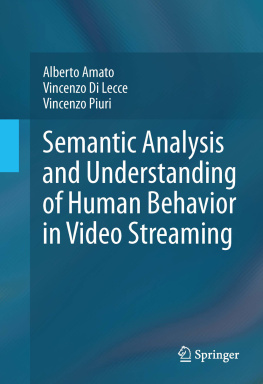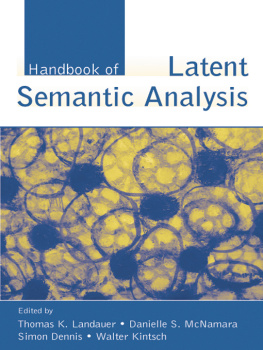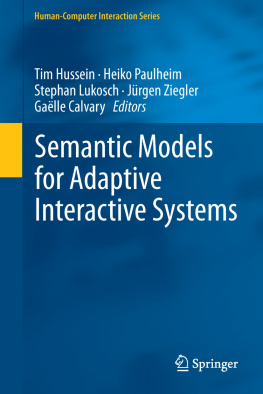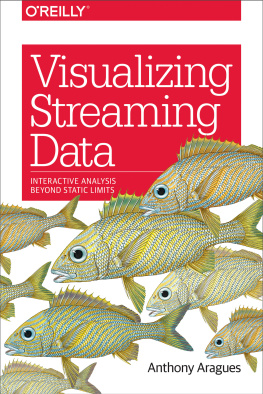Piuri Vincenzo - Semantic Analysis and Understanding of Human Behavior in Video Streaming
Here you can read online Piuri Vincenzo - Semantic Analysis and Understanding of Human Behavior in Video Streaming full text of the book (entire story) in english for free. Download pdf and epub, get meaning, cover and reviews about this ebook. City: New York;NY, year: 2013, publisher: Springer, genre: Computer. Description of the work, (preface) as well as reviews are available. Best literature library LitArk.com created for fans of good reading and offers a wide selection of genres:
Romance novel
Science fiction
Adventure
Detective
Science
History
Home and family
Prose
Art
Politics
Computer
Non-fiction
Religion
Business
Children
Humor
Choose a favorite category and find really read worthwhile books. Enjoy immersion in the world of imagination, feel the emotions of the characters or learn something new for yourself, make an fascinating discovery.
- Book:Semantic Analysis and Understanding of Human Behavior in Video Streaming
- Author:
- Publisher:Springer
- Genre:
- Year:2013
- City:New York;NY
- Rating:4 / 5
- Favourites:Add to favourites
- Your mark:
- 80
- 1
- 2
- 3
- 4
- 5
Semantic Analysis and Understanding of Human Behavior in Video Streaming: summary, description and annotation
We offer to read an annotation, description, summary or preface (depends on what the author of the book "Semantic Analysis and Understanding of Human Behavior in Video Streaming" wrote himself). If you haven't found the necessary information about the book — write in the comments, we will try to find it.
Piuri Vincenzo: author's other books
Who wrote Semantic Analysis and Understanding of Human Behavior in Video Streaming? Find out the surname, the name of the author of the book and a list of all author's works by series.
Semantic Analysis and Understanding of Human Behavior in Video Streaming — read online for free the complete book (whole text) full work
Below is the text of the book, divided by pages. System saving the place of the last page read, allows you to conveniently read the book "Semantic Analysis and Understanding of Human Behavior in Video Streaming" online for free, without having to search again every time where you left off. Put a bookmark, and you can go to the page where you finished reading at any time.
Font size:
Interval:
Bookmark:
- Surveillance . This application area has a relevant interest also due to the facts characterizing the history of the last decade. In particular, the aim of the applications in this area is monitoring and understanding human behavior in public and crowded areas (such as streets, bus and train stations, airports, shopping malls, sport arenas, and museums). These applications can be used both for management (for example: evaluation of crowding in the monitored areas, human flow analysis, and detection of the congestion points) and security (for example: human behavior analysis, activity recognition of individuals and groups, and detection of suspicious persons) [13].
- Control . In this area the researchers try to develop systems that are able to evaluate some human motion parameters (i.e. speed, gait) and/or the poses (i.e. the mutual position of the harms, or the position of the head) to control actions and/or operations [14]. One of the most important fields of application for these systems is the humanmachine interaction. On the market there are some interesting uses as input devices for videogames. These devices use both video and inertial sensors to evaluate the players motion and understand his/her commands.
- Analysis . Applications of human motion analysis are used in various fields, including: sports (as an aid for evaluating the techniques and the performance of the athletes), and medicine (as an aid in the diagnosis of problems in human postures and in the orthopedic rehabilitation) [15].
Font size:
Interval:
Bookmark:
Similar books «Semantic Analysis and Understanding of Human Behavior in Video Streaming»
Look at similar books to Semantic Analysis and Understanding of Human Behavior in Video Streaming. We have selected literature similar in name and meaning in the hope of providing readers with more options to find new, interesting, not yet read works.
Discussion, reviews of the book Semantic Analysis and Understanding of Human Behavior in Video Streaming and just readers' own opinions. Leave your comments, write what you think about the work, its meaning or the main characters. Specify what exactly you liked and what you didn't like, and why you think so.




![Mobile Library - Tools For Live Streaming 8: Video Editing Made Simple [ The 8 series--Vol 6 ]](/uploads/posts/book/385293/thumbs/mobile-library-tools-for-live-streaming-8-video.jpg)







